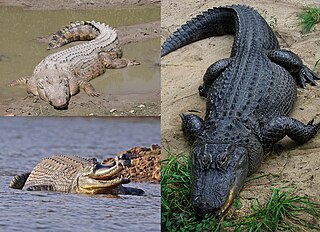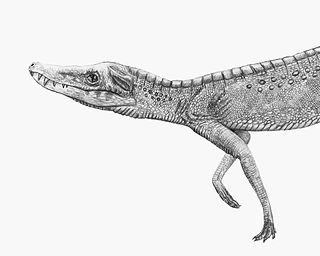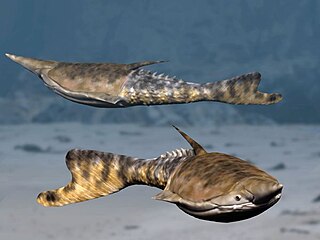Related Research Articles

A skeleton is the structural frame that supports the body of most animals. There are several types of skeletons, including the exoskeleton, which is a rigid outer shell that holds up an organism's shape; the endoskeleton, a rigid internal frame to which the organs and soft tissues attach; and the hydroskeleton, a flexible internal structure supported by the hydrostatic pressure of body fluids.

Crocodilia is an order of mostly large, predatory, semiaquatic reptiles known as crocodilians. They first appeared 94 million years ago in the Late Cretaceous period and are the closest living relatives of birds, as the two groups are the only known survivors of the Archosauria. Members of the order's total group, the clade Pseudosuchia, appeared about 250 million years ago in the Early Triassic period, and diversified during the Mesozoic era. The order Crocodilia includes the true crocodiles, the alligators and caimans, and the gharial and false gharial. Although the term crocodiles is sometimes used to refer to all of these, crocodilians is a less ambiguous vernacular term for members of this group.

A scute or scutum is a bony external plate or scale overlaid with horn, as on the shell of a turtle, the skin of crocodilians, and the feet of birds. The term is also used to describe the anterior portion of the mesonotum in insects as well as some arachnids.

Deinosuchus is an extinct genus of alligatoroid crocodilian, related to modern alligators and caimans, that lived 82 to 73 million years ago (Ma), during the late Cretaceous period. The name translates as "terrible crocodile" and is derived from the Greek deinos (δεινός), "terrible", and soukhos (σοῦχος), "crocodile". The first remains were discovered in North Carolina in the 1850s; the genus was named and described in 1909. Additional fragments were discovered in the 1940s and were later incorporated into an influential, though inaccurate, skull reconstruction at the American Museum of Natural History. Knowledge of Deinosuchus remains incomplete, but better cranial material found in recent years has expanded scientific understanding of this massive predator.

Cacops, is a genus of dissorophid temnospondyls from the Kungurian stage of the early Permian of the United States. Cacops is one of the few olsoniforms whose ontogeny is known. Cacops fossils were almost exclusively known from the Cacops Bone Bed of the Lower Permian Arroyo Formation of Texas for much of the 20th century. New material collected from the Dolese Brothers Quarry, near Richards Spur, Oklahoma in the past few decades has been recovered, painting a clearer picture of what the animal looked and acted like.

Doswellia is an extinct genus of archosauriform from the Late Triassic of North America. It is the most notable member of the family Doswelliidae, related to the proterochampsids. Doswellia was a low and heavily built carnivore which lived during the Carnian stage of the Late Triassic. It possesses many unusual features including a wide, flattened head with narrow jaws and a box-like rib cage surrounded by many rows of bony plates. The type species Doswellia kaltenbachi was named in 1980 from fossils found within the Vinita member of the Doswell Formation in Virginia. The formation, which is found in the Taylorsville Basin, is part of the larger Newark Supergroup. Doswellia is named after Doswell, the town from which much of the taxon's remains have been found. A second species, D. sixmilensis, was described in 2012 from the Bluewater Creek Formation of the Chinle Group in New Mexico; however, this species was subsequently transferred to a separate doswelliid genus, Rugarhynchos. Bonafide Doswellia kaltenbachi fossils are also known from the Chinle Formation of Arizona.

Osteoderms are bony deposits forming scales, plates, or other structures based in the dermis. Osteoderms are found in many groups of extant and extinct reptiles and amphibians, including lizards, crocodilians, frogs, temnospondyls, various groups of dinosaurs, phytosaurs, aetosaurs, placodonts, and hupehsuchians.

Junggarsuchus is an extinct genus of sphenosuchian crocodylomorph from the Middle or Late Jurassic period of China. The type and only species is J. sloani. The generic name of Junggarsuchus comes from the Junggar Basin, where the fossil was found, and the Greek word "souchos" meaning crocodile. The specific name, "sloani" is in honor of C. Sloan, who is credited with finding the holotype.

Pampatheriidae is an extinct family of large cingulates related to armadillos. They first appeared in South America during the mid-Miocene, and Holmesina and Pampatherium spread to North America during the Pleistocene after the formation of the Isthmus of Panama as part of the Great American Interchange. They became extinct as part of the end-Pleistocene extinctions, about 12,000 years ago.

Chroniosuchus is an extinct genus of chroniosuchid from the upper Permian period. The genus was first named by Vjuschkov in 1957.

The turtle shell is a shield for the ventral and dorsal parts of turtles, completely enclosing all the vital organs of the turtle and in some cases even the head. It is constructed of modified bony elements such as the ribs, parts of the pelvis and other bones found in most reptiles. The bone of the shell consists of both skeletal and dermal bone, showing that the complete enclosure of the shell likely evolved by including dermal armor into the rib cage.

Eutretauranosuchus is an extinct genus of goniopholidid crocodyliform. E. delfsi is the only known species within the genus.

Armadillosuchus is an extinct genus of sphagesaurid crocodylomorph. It was described in February 2009 from the late Campanian to early Maastrichtian Adamantina Formation of the Bauru Basin in Brazil, dating to approximately 70 Ma. Armadillosuchus was among the larger and more robust sphagesaurids, with a total length of approximately 2 metres (6.6 ft).
Cerrejonisuchus is an extinct genus of dyrosaurid crocodylomorph. It is known from a complete skull and mandible from the Cerrejón Formation in northeastern Colombia, which is Paleocene in age. Specimens belonging to Cerrejonisuchus and to several other dyrosaurids have been found from the Cerrejón open-pit coal mine in La Guajira. The length of the rostrum is only 54-59% of the total length of the skull, making the snout of Cerrejonisuchus the shortest of all dyrosaurids.

Tsoabichi is an extinct genus of caimanine crocodylian. Fossils are known from the Green River Formation in Wyoming, and date back to the Ypresian stage of the Eocene. The genus was named and described in 2010 by paleontologist Christopher A. Brochu, with the type species being Tsoabichi greenriverensis. According to the current understanding of caiman evolutionary relationships, Tsoabichi is a basal member of Caimaninae and may have evolved after caimans dispersed into North America from northern and central South America, their main center of diversity in the Cenozoic.

Planocraniidae is an extinct family of eusuchian crocodyliforms known from the Paleogene of Asia, Europe and North America. The family was coined by Li in 1976, and contains three genera, Boverisuchus, Duerosuchus and Planocrania. Planocraniids were highly specialized crocodyliforms that were adapted to living on land. They had extensive body armor, long legs, and blunt claws resembling hooves, and are sometimes informally called "hoofed crocodiles".

Anthracosuchus is an extinct genus of dyrosaurid crocodyliform from the Paleocene of Colombia. Remains of Anthracosuchus balrogus, the only known species, come from the Cerrejón Formation in the Cerrejón mine, and include four fossil specimens with partial skulls. Anthracosuchus differs from other dyrosaurids in having an extremely short (brevirostrine) snout, widely spaced eye sockets with bony protuberances around them, and osteoderms that are smooth and thick. It is one of the most basal dyrosaurids along with Chenanisuchus and Cerrejonisuchus.

A plate in animal anatomy may refer to several things:
Osteoderms are dermal bone structures that support the upper layer of skin and serve as protection against the elements in a large variety of extinct and extant organisms, especially reptiles. This structure is commonly called "dermal armor" and serves to protect the organism, while also helping with temperature regulation. Osteoderms represent hard tissue components of the integument, making them easy to identify in fossil examination. This dermal armor is found prominently in many lizards. Some early amphibians have this armor, but it is lost in modern species with the exception a ventral plate, called the gastralia.

Knoetschkesuchus is a genus of small atoposaurid crocodylomorph from the Late Jurassic of Germany and Portugal. Two species are known: the German species K. langenbergensis, described by Schwarz and colleagues in 2017 based on two partial skeletons and various isolated bones; and the Portuguese species K. guimarotae, named from over 400 specimens including several partial skeletons. Knoetschkesuchus was a small and short-snouted crocodilian, measuring about 55 centimetres (22 in) in length, that primarily fed on small prey, including invertebrates, amphibians, and mammals. This specialization towards small prey ecologically separated Knoetschkesuchus from most of the other diverse crocodilians that it lived with in the island ecosystem of Jurassic Europe.
References
- ↑ de Buffrénil, V.; Clarac, F.; Fau, M.; Martin, S.; Martin, B.; Pellé, E.; Laurin, M. (2015). "Differentiation and growth of bone ornamentation in vertebrates: a comparative histological study among the Crocodylomorpha". Journal of Morphology. 276 (4): 425–445. doi: 10.1002/jmor.20351 . PMID 25488816. S2CID 10809084.
- ↑ Chen, I.H.; Kiang, J.H.; Correa, V.; Lopeza, M.I.; Chen, P.Y.; McKittrick, J.; Meyers, M.A. (2011). "Armadillo armor: mechanical testing and micro-structural evaluation". Journal of Animal Ecology. 4 (5): 713–722. doi:10.1016/j.jmbbm.2010.12.013. PMID 21565719.
- ↑ Broeckhoven, Chris; Diedericks, G.; Mouton, P. le Fras N. (2015). "What doesn't kill you might make you stronger: functional basis for variation in body armour". Journal of Animal Ecology. 84 (5): 1213–1221. doi: 10.1111/1365-2656.12414 . PMID 26104546.
- ↑ Clarac, F.; Goussard, F.; de Buffrénil, V.; Sansalone, V. (2019). "The function(s) of bone ornamentation in the crocodylomorph osteoderms: a biomechanical model based on a finite element analysis". Paleobiology. 45 (1): 182–200. doi:10.1017/pab.2018.48. S2CID 92499041.
- ↑ Clarac, F.; Quilhac, A. (2019). "reptile The crocodylia skull and osteoderms: A functional exaptation to ectothermy?". Zoology. 132: 31–40. doi: 10.1016/j.zool.2018.12.001 . PMID 30736927. S2CID 73427451.
- ↑ Jackson, D.C.; Goldberger, Z.; Visuri, J.; Armstrong, R.N. (1999). "Ionic exchanges of turtle shell in vitro and their relevance to shell function in the anoxic turtle". Journal of Experimental Biology. 202 (5): 503–520. doi:10.1242/jeb.202.5.513. PMID 9929454.
- ↑ Jackson, DC.; Andrade, D.; Abe, AS. (2003). "Lactate sequestration by osteoderms of the broad-nose caiman, Caiman latirostris, following capture and forced submergence". Journal of Experimental Biology. 206 (20): 3601–3606. doi: 10.1242/jeb.00611 . PMID 12966051.
- ↑ Clarac, F.; de Buffrénil, V.; Cubo, J.; Quilhac, A. (2018). "Vascularization in ornamentedosteoderms: physiological implications in ectothermy and amphibious lifestyle in the crocodylomorphs?". Anatomical Record. 301 (1): 175–183. doi: 10.1002/ar.23695 . PMID 29024422.